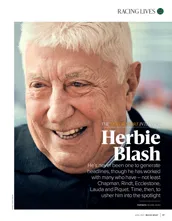Statistically, Peterson’s career is not especially impressive, with 10 victories from his 123 Grands Prix. But statistics alone cannot tell of a man’s significance in his sport. In only four of his nine years in Formula One did he win races, and the truth is that much of his career was squandered on poor cars. For example, he raced 47 times for March in two spells — from 1970-72 and then again in 1976 — and those races yielded but a single victory. On the other hand, it’s worth pointing out that his victory at Monza in 1976 in the March 761 was the works team’s only ‘full’ Grand Prix victory, Vittorio Brambilla only being granted half points after his rain-shortened win in Austria in 1975.
By the end of 1977, there were many who believed Ronnie’s great days done. With Lotus he had excelled in 1973 and ’74, leaving few in any doubt of his status as the fastest there was, but new cars from Chapman failed to deliver, and early in 1976 Peterson returned to March, then spent a lacklustre season in Ken Tyrrell’s six-wheelers. He just didn’t have it any more, people said; he was pudgy and unfit, not the charger of old. Ronnie admitted that the spark was temporarily gone. “I got very depressed, and it affected me. It was another season wasted, and one I’d expected to be good.” Thus, he began talking to Chapman once more. “I looked at what Mario had achieved with the Lotus 77. That car was dreadful when I left, but he and Colin made a winner of it. Then I saw the 78 usually lapping me! and knew I had to get back there somehow. It was no time to be proud.”

Monaco again, but now in the Lotus 72 – he would win this ’74 race in a car which was now on its fifth season
Grand Prix Photo
So, cap in hand, he went back to his old boss, and in the cap were sizeable cheques from a couple of sponsors. It may seem an absurdity today that a great driver should need to buy a ride, but Peterson knew how Chapman’s mind worked; knew, too, that his own stock was low.
Andretti did not initially welcome the idea, reasoning that he had dragged Lotus back from the mire, and was now being asked to share the harvest of his work. “Tell me where it’s written we need two stars in this team,” Mario growled. “When Peterson and Fittipaldi ran at Lotus together in ’73, they won a bunch of races and neither won the championship. I don’t want that to happen again. I’ve signed as number one, but I feel bad that Ronnie has to accept number two, because that’s not what he is.”






